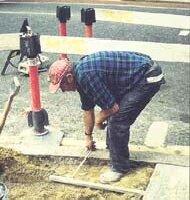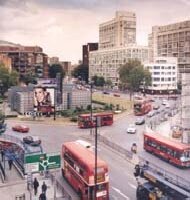Highways Engineers


Places & Infrastructure
Everyone looks at the ground! The historic environment is not all buildings and monuments; the spaces in between have a visual impact. Highways and footpaths are often older than surrounding buildings; their line, construction materials and furniture can all be important. They contribute to our appreciation and enjoyment of a place. Good quality and appropriate design will have a lasting, positive impact on the local area and the people who use it daily.
- Street surfacing is an integral part of the appearance of an area and the way in which it is used. It is important to reinstate groundworks sympathetically.
- Signs and barriers are sometimes required for safety. But they can be kept to a minimum and positioned thoughtfully to avoid clutter and obstruction. Studies have shown that many items of street furniture are unnecessary.
- Bollards and bus shelters, even drains and paving may be of historic significance. Further information on rarity and importance may be required before removing or altering features and structures.
- Digging trenches may remove or expose buried archaeology. Where possible, find out what you might encounter before works start.
Measures such as road layouts, traffic calming, pedestrianisation, access and mobility in relation to public realm can all have an impact on the surrounding historic environment. Simple design principles such as reducing clutter, co-ordinating street furniture where appropriate and reinforcing local character will help ensure that the street scape complements rather than detracts from the surrounding buildings. Good design will also ensure that the street is accessible to all while maintaining local character.
Streets for All
English Heritage has published Streets for All manuals for each region. Produced in conjunction with the Department for Transport, these give practical advice on the design, management and conservation of streets, particularly in historic areas. A summary of the Streets for All approach is available. Copies of the manuals for your region are available in PDF version. Alternatively contact your English Heritage regional office or email for hard copies.
Working in partnership with planning and conservation colleagues as well as the local community enables integrated townscape management. It is possible to combine functionality, consideration for the historic environment and creativity. There are many sources of specialist advice ranging from your in-house Conservation team to published guidance. The HELM project offers links to information and training.
Guidance and policy documents are available on this website when accessed through the website's five topic buttons: Regeneration & Design, Understanding & Recording, Place & Placemaking, Managing & Protecting and Funding. English Heritage documents can also be searched and downloaded as a PDF by using the Guidance Library.
The HELM website has a list of guidance produced by local authorities, amenity groups and relevant bodies which can also be found using the Guidance Library. Case Studies may be searched for examples of good practice across the country.
HELM offers training for councillors and officers in local authorities and government agencies.
